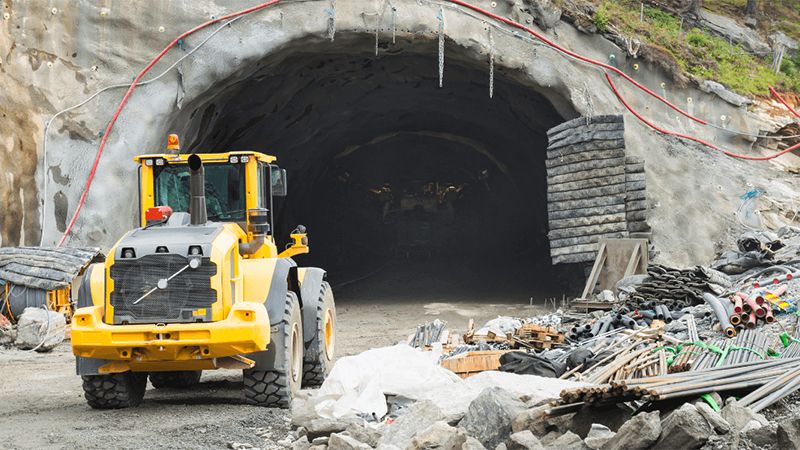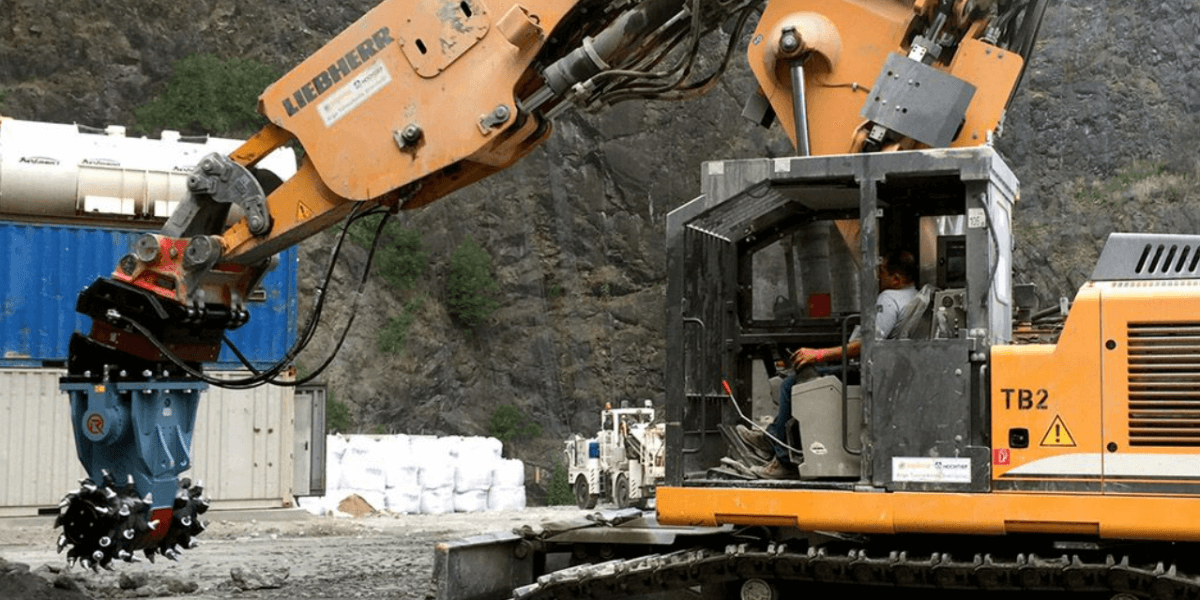Top Equipment Used in Tunnel Construction and How It Works

Digging tunnels through hard rock, sand, and soil is about more than creating underground pathways. It requires precision, power, and problem-solving at every step.
The key lies in the advanced equipment used in tunnel construction, which handles everything from deep excavation to wall reinforcement and debris removal. What does it take to excavate tunnels efficiently while keeping workers safe?
Tunnel boring machines carve through solid rock. Conveyor systems move heavy materials with ease. Shotcrete machinery strengthens tunnel walls, and Rockwheel attachments bring accuracy to complex jobs. Each machine plays a critical role in turning plans into underground realities.
This guide explores all the essential equipment, their purpose, and how they conquer the challenges of tunneling. Ready to uncover the tools behind these engineering marvels? Let’s dig in.
Key Takeaways
- Building tunnels takes powerful machines, smart systems, and precision materials working in harmony.
- From TBMs to shotcrete, specialized tools make tunneling faster, safer, and more efficient.
- With innovation and the right equipment, even the toughest underground challenges can be conquered.
Core Machines That Shape Tunnels
Building tunnels through rock and soil requires powerful machines designed for precision and adaptability. Here’s a closer look at the heavy hitters of tunnel construction:
Tunnel boring machines (TBMs): Giants of the underground
Tunnel boring machines create tunnels with a circular cross-section by using a rotating cutting head to grind through hard rock and soil. As they move forward, conveyor systems remove excavated material, keeping the construction site efficient.
Different types of TBMs handle various ground conditions. Earth Pressure Balance TBMs are ideal for loose soils, Hard Rock TBMs conquer solid stone, and Slurry TBMs manage projects with high water ingress.
Their size and efficiency make them essential for large-scale tunnel excavation, though they require expert operation and careful planning.
Drill jumbos: Precision drilling in hard rock
Drill jumbos are specialists in accuracy. Equipped with multiple booms, they drill precise patterns into hard rock, often for explosives or installing rock bolts.
They also play a key role in preparing tunnel walls for reinforcement, which makes them essential for projects requiring stability and safety.
Roadheaders: Flexible excavators
Roadheaders are increasingly popular in tunnel construction for their flexibility, mobility, and eco-friendly design. With adjustable cutting heads, booms, hydraulic systems, and conveyors, they handle various tunnel sizes, shapes, and openings with ease.
Ideal for soft to medium-strength rocks like sedimentary formations, roadheaders excel in mixed ground conditions and tight spaces where TBMs aren’t practical. Their built-in conveyors efficiently manage debris, enhancing safety and productivity on site.
Moving Muck and Crushing Rock
Digging a tunnel is just the first step. The next challenge is managing the mountains of debris left behind. Specialized equipment steps in to handle the heavy lifting, keeping the construction site clear and operations efficient.
Conveyors and loaders: Fast and reliable
Continuous belt conveyors are the backbone of muck removal, running nonstop to transport debris out of the tunnel. They are especially valuable in long tunnels, where carrying material by truck would be too slow.
Loaders work in tandem, scooping up rock and soil to transfer it to crushers or dump trucks. Their hydraulic power and precision keep the process running like clockwork.
Crushers: Rock made manageable
Once excavated material reaches the surface, crushers take over. These machines break large rocks into smaller, uniform pieces that are easier to transport or repurpose.
Mobile crushers add flexibility, working right at the construction site to cut down on extra hauling. By simplifying material handling, crushers play a key role in keeping tunnel construction efficient.
Dump trucks: Hauling the heavy stuff
Dump trucks may not grab headlines, but they’re vital to the process. These machines haul away processed material, from gravel to crushed rock, to designated storage or disposal areas.
Modern dump trucks are designed for maximum capacity and fuel efficiency, making them perfect for the tough conditions of a construction site.
Strengthening the Tunnel
Building a tunnel is only half the job—keeping it stable and safe is just as critical. Here’s how key systems make it happen:
Shotcrete: Quick wall reinforcement
Shotcreting machines spray wet concrete onto tunnel walls, forming a protective layer in seconds. This fast, efficient process stabilizes loose surfaces and adapts to uneven ground, making it a top choice for reinforcing tunnels.
Steel supports: Built to last
Temporary supports hold the tunnel in place during excavation, while permanent steel frameworks ensure long-term stability. Lattice girders and rock bolts work together to create a strong foundation, especially in areas with soft or shifting ground.
Ventilation: Fresh air for safe work
Ventilation systems maintain safe air quality inside and outside tunnels by drawing fresh air from the entry and circulating it with jet fans or vehicle movement.
Short tunnels often use natural ventilation, while longer tunnels rely on mechanical systems like longitudinal or transverse airflow. Dust collectors enhance safety by filtering debris, ensuring a clean environment for workers and machinery.
Keep Things on Track
While tunneling equipment takes care of excavation, auxiliary systems keep everything on track. These tools provide accuracy, materials, and sustainability to make tunnel construction seamless.
Surveying tools: Guiding every step
Surveying tools are essential for keeping tunnels on the right path. GPS systems, lasers, and theodolites work together to measure alignment, grade, and depth with pinpoint accuracy.
Modern software processes this data in real-time, giving engineers instant feedback to adjust plans when geological conditions shift. This combination of technology and tools helps maintain the precision required for complex tunnel applications.
Batch plants: Concrete when you need it
Batch plants are command centers for producing on-demand concrete. By mixing cement, water, and aggregates on-site, these plants provide fresh shotcrete or concrete tailored to the tunnel’s specific needs.
This flexibility is especially important when different sections of a tunnel require varying types of concrete. Batch plants keep production consistent, cost-effective, and ready for immediate application.
Water treatment facilities: Clean and compliant
Tunnel construction often creates muddy, debris-filled water that must be managed. Water treatment facilities turn this wastewater into something usable or safe for disposal.
These systems filter out sediments and contaminants so that operations remain compliant with environmental regulations. They’re a critical part of sustainable tunnel construction because they help reduce waste and support environmental care.
RockZone Americas: Your Trusted Equipment Partner

For over 50 years, RockZone Americas has been a trusted name in providing advanced excavation and material-handling solutions. Our cutting-edge equipment is designed to tackle the most demanding tunneling and construction projects, delivering precision, efficiency, and reliability.
RockZone offers a wide range of specialized tunneling equipment to meet the unique challenges of underground construction.
Our products, like Rockwheels, excel in precision excavation and concrete milling, while Rockcrushers simplify material handling with efficient rock and debris processing. For projects requiring soil treatment, our Soil Mixers provide unmatched scalability and power.
Why choose RockZone Americas?
- Reliability: Built with premium materials to handle tough conditions.
- Versatility: Designed for a range of applications, including excavation, trenching, scaling, and more.
- Expertise: Our team offers unmatched support to help you choose the right tools for your needs.
- Sustainability: Products like our Rockscreeners and Rockcrushers promote recycling and efficient material use.
Explore our tools today
From tunneling to demolition, RockZone Americas has the equipment to redefine your project’s success. Contact us today to learn how our innovative tools can transform your construction challenges into accomplishments.
Conclusion
Specialized tunneling equipment has transformed underground construction, making projects faster, safer, and more efficient. Machines like TBMs, roadheaders, and shotcrete systems tackle complex challenges with precision and reliability, paving the way for incredible achievements.
With ongoing innovation and trusted partners like RockZone Americas, the future of tunneling looks promising. Advanced technology and expert solutions are making even the toughest projects possible, shaping a smarter and more connected world.
Frequently Asked Questions
What equipment is used to make a tunnel?
Tunneling calls for a powerhouse lineup of machines.
Tunnel boring machines (TBMs) handle the heavy lifting, while roadheaders, drill jumbos, and shotcreting machines add precision and reinforcement. Conveyor systems and crushers tackle material handling, making the process efficient from start to finish.
What materials are used in tunnel Construction?
Tunnel construction relies on materials like concrete for lining, steel for supports, and shotcrete for reinforcing walls. Additional essentials include grouting compounds to fill voids and rocks or aggregate for backfilling or added stability in various sections.
What equipment do they use to find tunnels?
Surveying tools like GPS systems, theodolites, and lasers are key for locating and aligning tunnels. Ground-penetrating radar and other advanced geotechnical equipment help identify underground features and assess geological conditions before digging begins.
What are the components of tunnel construction?
Tunnel construction combines several elements: excavation, lining with concrete or shotcrete, installing ventilation systems, and adding supports like rock bolts or lattice girders. Material removal, drainage systems, and finishing touches like lighting round out the process.
What is shotcrete in a tunnel?
Shotcrete is a specialized concrete mix sprayed onto tunnel walls at high speed to create a strong, protective layer. It stabilizes loose surfaces, fills gaps, and adapts easily to uneven ground, making it a go-to solution for reinforcing tunnels.
What are the problems with tunnel construction?
Tunnel projects face challenges like water ingress, unstable ground, and high costs for specialized equipment. Issues with ventilation, material removal, and navigating complex geological conditions can also complicate construction, requiring precise planning and execution.
